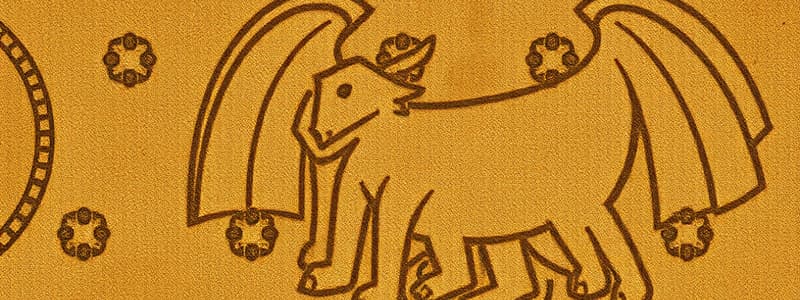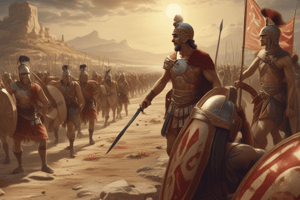Podcast
Questions and Answers
Which of the following was NOT a stated aim of the Delian League upon its formation in 478 BC?
Which of the following was NOT a stated aim of the Delian League upon its formation in 478 BC?
- To establish Athenian dominance over all Greek city-states. (correct)
- To liberate the Greeks of Asia Minor from Persian control.
- To seek compensation from the Persians for damages incurred.
- To provide future security against further Persian attacks.
Aristides determined the tribute members would pay to the Delian League, but the tribute amount was fixed permanently and never changed.
Aristides determined the tribute members would pay to the Delian League, but the tribute amount was fixed permanently and never changed.
False (B)
What was the significance of moving the Delian League's treasury from Delos to Athens in 454 BC?
What was the significance of moving the Delian League's treasury from Delos to Athens in 454 BC?
Symbolized and enabled Athenian control
The Athenian officials who looked after the funds kept on Delos were called ______ treasurers.
The Athenian officials who looked after the funds kept on Delos were called ______ treasurers.
Match the following individuals with their roles in the Delian League:
Match the following individuals with their roles in the Delian League:
Which of the following best describes the transformation of the Delian League?
Which of the following best describes the transformation of the Delian League?
The Battle of Eurymedon was a minor skirmish with little strategic consequence for the Delian League.
The Battle of Eurymedon was a minor skirmish with little strategic consequence for the Delian League.
What was the significance of the 'Coinage Decree' issued by Athens?
What was the significance of the 'Coinage Decree' issued by Athens?
The practice of ______ involved expelling prominent political figures from Athens for a set period.
The practice of ______ involved expelling prominent political figures from Athens for a set period.
Match the social classes introduced by Solon with their descriptions:
Match the social classes introduced by Solon with their descriptions:
Which of the following was a consequence of the Delian League's actions against Naxos?
Which of the following was a consequence of the Delian League's actions against Naxos?
A colony and a kleruchy are the same thing; they both designate a politically independent settlement.
A colony and a kleruchy are the same thing; they both designate a politically independent settlement.
What democratic reform is associated with Cleisthenes?
What democratic reform is associated with Cleisthenes?
The ______ Decree restricted autonomy of local courts, this decree occurred in _____.
The ______ Decree restricted autonomy of local courts, this decree occurred in _____.
Match the event with its significance to formation of an Athenian Empire
Match the event with its significance to formation of an Athenian Empire
According to sources, what contributed to Athens' development into an empire?
According to sources, what contributed to Athens' development into an empire?
According to historians, it is unlikely the Delian League becoming the Athenian Empire happened over time.
According to historians, it is unlikely the Delian League becoming the Athenian Empire happened over time.
Name some of Athens' methods of control for allies.
Name some of Athens' methods of control for allies.
The power was ______ and conducted in the ______
The power was ______ and conducted in the ______
Match the Athenian development with its democratic development.
Match the Athenian development with its democratic development.
What best exemplifies the Athenian control of Allied state economic control?
What best exemplifies the Athenian control of Allied state economic control?
The Chalcis Decree expanded local court autonomy.
The Chalcis Decree expanded local court autonomy.
How did Athens justify using the Delian league funds?
How did Athens justify using the Delian league funds?
Athens use of military force was display by __________ after it tried to secede.
Athens use of military force was display by __________ after it tried to secede.
What was Aritstides primary role?
What was Aritstides primary role?
What did the oath by Herodotus ensure to Allied States?
What did the oath by Herodotus ensure to Allied States?
Due to the reliance on naval power, the influence of thetes decreased.
Due to the reliance on naval power, the influence of thetes decreased.
Who lead with a more aggressive foreign policy?
Who lead with a more aggressive foreign policy?
The people's assembly had no real power in _______.
The people's assembly had no real power in _______.
Match the following individuals with their roles associated Athens turning democratic:
Match the following individuals with their roles associated Athens turning democratic:
What was established that gave Athens access to grain?
What was established that gave Athens access to grain?
The Ecclesia, Athens people's assembly, would consider laws.
The Ecclesia, Athens people's assembly, would consider laws.
List the changes that occurred in the power of Athens Archons?
List the changes that occurred in the power of Athens Archons?
The introduction of ___________ led to the poorest Athenians now able to participate in the law courts.
The introduction of ___________ led to the poorest Athenians now able to participate in the law courts.
Match Athens actions with is end goal.
Match Athens actions with is end goal.
Flashcards
Delian League
Delian League
An alliance of Greek states formed in 478 BC, led by Athens, to liberate Ionian states and defend against Persia.
Delian League Headquarters
Delian League Headquarters
Established in 478-477 BC on the island of Delos, functioning as the league's central meeting and treasury location.
Aristides' role in Delian League
Aristides' role in Delian League
Aristides, known for his integrity, determined tribute amounts based on members' worth and ability to pay into the Delian League.
Aims of the Delian League
Aims of the Delian League
Signup and view all the flashcards
Founding Members of the Delian League
Founding Members of the Delian League
Signup and view all the flashcards
Organisation of the Delian League
Organisation of the Delian League
Signup and view all the flashcards
Features of the Delian League
Features of the Delian League
Signup and view all the flashcards
Cimon's early actions
Cimon's early actions
Signup and view all the flashcards
Capture of Scyros
Capture of Scyros
Signup and view all the flashcards
League forced a non-league state to join
League forced a non-league state to join
Signup and view all the flashcards
Revolt of Naxos
Revolt of Naxos
Signup and view all the flashcards
Battle of the Eurymedon River
Battle of the Eurymedon River
Signup and view all the flashcards
A colony
A colony
Signup and view all the flashcards
Kleruchy
Kleruchy
Signup and view all the flashcards
Cimon's Contributions
Cimon's Contributions
Signup and view all the flashcards
Revolt of Thasos (465 BC)
Revolt of Thasos (465 BC)
Signup and view all the flashcards
Egyptian campaign (459BC)
Egyptian campaign (459BC)
Signup and view all the flashcards
Peace of Callias (449 BC)
Peace of Callias (449 BC)
Signup and view all the flashcards
Thirty Year Peace (446 BC)
Thirty Year Peace (446 BC)
Signup and view all the flashcards
Revolts of Euboea and Samos (447 BC)
Revolts of Euboea and Samos (447 BC)
Signup and view all the flashcards
Instruments of Athenian Empire
Instruments of Athenian Empire
Signup and view all the flashcards
Athenian Tribute Lists
Athenian Tribute Lists
Signup and view all the flashcards
League's Treasury
League's Treasury
Signup and view all the flashcards
Coinage Decree
Coinage Decree
Signup and view all the flashcards
Erythrae Decree
Erythrae Decree
Signup and view all the flashcards
Oaths by Herodotus
Oaths by Herodotus
Signup and view all the flashcards
Buckley
Buckley
Signup and view all the flashcards
Congress Decree
Congress Decree
Signup and view all the flashcards
Influence
Influence
Signup and view all the flashcards
Athens Social Tension
Athens Social Tension
Signup and view all the flashcards
Persian war
Persian war
Signup and view all the flashcards
Other moves
Other moves
Signup and view all the flashcards
Archon
Archon
Signup and view all the flashcards
Money
Money
Signup and view all the flashcards
Solon's class system
Solon's class system
Signup and view all the flashcards
Study Notes
- The Greek world between 500-440BC covered the Persian Wars, development of Athens/Athenian Empire, and Athens and Sparta.
Development of Athens and the Athenian Empire
- Key areas of focus are the Delian League, the transformation of the Delian League, Athenian Imperialism, and key democratic developments.
- These key words are important for HSC questions.
The Delian League (Origins)
- Origins date back to 478 BC
- The Greeks were concerned about a possible return of the Persians after they were expelled.
- Athens rose to prominence after the Persian Wars and took over leadership of the Greeks from Sparta.
- Between 478-450 BC, the alliance of Greek states gradually transformed into an Athenian empire.
- A maritime confederation, the Delian League, was formed in 478 BC and included newly liberated Ionian states and other Greek states led by Athens.
- Modern scholars refer to it as the Delian League, but the Greeks called it "Athenians and their allies."
- The league grew out of the Hellenic League after the Greek victory at Mycale.
- Athens assumed leadership because of Pausanius' behavior in Ionia.
- Thucydides recalls that the Athenians “took over the leadership".
- Sparta relinquished command fearful of a helot revolt.
- Athens assumed leadership based on naval power, success at Salamis, and faith in Aristides the Just.
- Aristides and Cimon accepted the League's leadership.
Delian League (Aims)
- Sought compensation from the Persians for damage to Greece.
- Thucydides said the goal was to compensate for losses by ravaging Persian territory.
- Liberated Greeks of Asia Minor who were under Persian control.
- The League maintained freedom.
- Provided future security against another Persian attack.
- Gained regular contributions from allies to maintain the fleet.
- Headquarters were established on Delos.
- Founding members included Chios, Athens, Samos, Lesbos, and most Ionian states.
Delian League (Organisation)
- In 478-477 BC, Athenians held their first meeting for interested parties on Delos, an important Greek center.
- Delos has an excellent harbour, is geographically well-positioned and politically neutral in the Aegean Sea area.
- The treasury was kept on Delos, managed by Athenian officials called Hellenic treasurers.
- A League council or synod was established, including all members who voted on policies and actions.
- It is uncertain if all members had an equal vote, but initially all states were independent.
- Historians debate whether the League was unicameral or bicameral.
- The council met yearly and decided on policy/strategy.
- Membership was permanent, illustrated by Aristotle as throwing iron bars into the sea.
- Aristides determined tribute amounts: 460 talents per year, paid every four years.
- Larger islands like Chios, Lesbos, Naxos, and Samos sometimes gave ships as tribute.
- Tributary cities proved to be expensive, so they paid money instead.
- According to Plutarch, Aristides played a pivotal role in the collection of revenue.
- The money collected was called phoroi, was kept in the Delos treasury.
Delian League (Activities to the Battle of the Eurymedon River)
- 479-478 BC: Delian League was formed.
- 472 BC: A non-league state was forced to join.
- 476-475 BC: Under Cimon, the League captures Thrace and removes Persians, increasing resources like silver and timber.
- 474-473 BC: Scyros was captured, removing a pirate threat valuable to the route to the Hellespont.
- 469 BC: Naxos tried to leave, but the League put down the revolt and forced Naxos to stay as a tribute-paying subject ally.
- At the Battle of Eurymedon, Xerxes assembled a force against Greece in Pamphlyia, Asia Minor. Cimon organized 300 ships, 200 of which were Athenian.
- The fleet sailed to the mouth of the Eurymedon, where 200 Persian ships were sunk. Plutarch describes a furious battle where the army was captured.
- Cimon sailed to Cyprus and defeated a Persian-led Phoenician fleet, a decisive victory in the Greco-Persian conflict. Plutarch says it dashed the king's hopes, leading him to accept peace terms.
- The Delian League's victory showed it could protect Greece from Persian designs.
Naxos (Revolt and Subjugation)
- Naxos left the League and the Athenians made war.
- After a siege, Naxos was forced back to allegiance.
- It was the first case when the original constitution of the League was broken, and an allied city lost its independence.
- Revolts were caused by failures to produce the correct amount of ships/tribute or refusals to produce them.
- The Athenians insisted on obligations being exactly met, making them unpopular.
- The Athenians rulers were no longer as popular.
Colony vs Kleruchy
Colony
- Politically independent of original city-state.
- Inhabitants were no longer citizens of the original city-state.
Kleruchy
- Settlers were still citizens of the original city-state.
- Way to deal with excess population.
- Settlers acted as watchdogs for the original city-state.
- The Athenians established the kleruchies all over the Aegean area.
The Delian League (Activities Before the Battle of the Eurymedon River)
- The initial decade of the Delian League involved liberating Ionia and expelling Persians from Aegean bases.
- The Athenians gradually assumed leadership between 479-467 BC.
- Persians expelled from Thrace, control taken of Scyros, and Carytus forced into the League.
- The League's response to Naxos, in 469 BC, shows off its control.
- Aristides was responsible for early organization and collecting tribute.
- Xanthippus (Pericles’ father) was involved in early naval actions of the League.
- Cimon became the most significant leader, pursuing an anti-Persian policy.
- Victory at the Battle of the Eurymedon River marked the pinnacle of Cimon’s career.
- Members start to pay tribute in monetary form.
- Some larger states resented paying tribute because they felt that they have no need for the fleet.
- In 469 BC, Athens uses League forces under Cimon to besiege and force Naxos to submit.
The Delian League (Benefits and Disadvantages)
- Lists of both for the Allies and for Athens were read and highlighted
- Ken Webb was also used from top of page 78
Cimon and Aristides (Role and Contribution)
- Notes were gathered from reading and highlighting Webb pages 81-88 as well as Antiquity 2 from P466 and Plutarch.
Aristides
- Known as "the Just"
Cimon
- Miltiades' son
- He was a commander of naval expeditions in the early years of the League.
- Commanded operations at Eion, Scyros, the Eurymedon River, and Thasos.
- Described as a “singularly efficient strategist…a capable politician".
- By the mid-460s, he became the most prominent man in Athens.
- There was conflict over policies with Ephialtes.
HSC 2023: Role of Cimon and Aristides (Development of Athens and its Empire)
- Generals gained political support and influence to become leaders.
- Cimon was elected strategos for seventeen years (479-462), led expeditions, and persuaded the assembly to support his policies.
Transformation of the Delian League into the Athenian Empire
- After battle of Eurymedon River, the League continued to grow in strength and the Greeks now felt secure in the Aegean and Asia Minor.
- Thasos revolted in 465 BC and attempted to leave the League but was punished after a two year struggle. Athens showed their power and might not allowing any state to leave the League.
- With the emergence of Pericles, Cimon was ostracized and Ephialtes was assassinated and Pericles commenced with his aggressive foreign policy.
- 461-445 BC saw the First Peloponnesian War where Athens fought against allies of Sparta, highlighting League dominance.
- In 459 BC, there was the Egyptian campaign where Athens attempted to help the Egyptians expel the Persians but was defeated and Persian activity was renewed in the Aegean.
- In 454 BC, the treasury was moved from Delos to Athens for safekeeping and no further Delian league meetings were held on Delos.
- 451 BC: Cimon negotiated a Five year Truce with Sparta and Pericles signed the Thirty-Year Peace between Athens and Sparta in 446 BC.
- 449 BC: Peace of Callias was made with Persia, as Pericles wanted to consolidate Athens.
- Revolts of Euboea and Samos were in 447 BC, with the Samian forced to surrender after 9 months and heavy terms imposed.
Athenian Imperialism (Nature and Changing Relations with Allies)
Factors:
- Economic, Military/Naval, Judicial, Political
- Athenian methods of control: Economic, Military/Naval, Judicial, Political
Athenian Imperialism (Areas of Control)
Economic
- Tribute Lists shows annual contributions to the League.
- League members forced to pay tribute, including naval ships.
- Athens controlled members' trade, restricted trading rights, and prohibited relations with Sparta.
- The Leagues' Treasury was dominated by Athenian “Hellenotomiai” which contributed to the development.
- In 454 BC, the treasury was moved from Delos to Athens
- In 450-446 BC, the Coinage Decree forced Allied states to adopt Athenian currency, weights, and measures.
Political
- In 453-452, The Erythrae Decree demonstrates Athens forced imposition of democracy on the Ionian city of Erythrae (“A council of 120 men is to be chosen by lot”).
- Allied states were forced to adopt similar systems of government to Athens and ensure significant control of Allied states' political affairs.
- Athens controlled members' foreign policy independent actions and relations with Sparta and Persia were prohibited.
- Pericles was accused of enforcing the citizenship law and the use of ostracism.
- There was an Imposition of cleruchies.
Judicial/Social
- Herodotus stated social authority the oath insured over Allied states and the permanency of the oath.
- Athens usually established a cleruchy, a colony of Athenian citizens, if a member state revolted.
- A cleruchy were implemented and formed as a military garrison.
- Athens implemented garrison and ensured suspicious states stayed loyal to Athens
- Pericles bought 1000 colonists with him.
- Athens increasingly demanded legal affairs of its allies be heard in its own courts, who would manipulate the outcomes.
- Democratic governments were also installed in member states previously ruled by tyrants or oligarchs
- The Chalcis Decree restricted the autonomy of local courts and many cases were heard in Athens
Military/Naval
- The The Congress Decree: "need for security of seas”. Allied states lacked power to oppose Athenian naval forces, paid large expenses, and made ships to avoid military service.
- Athens received reinforcement from Chios and Lesbos in Samos 440 BC, increasing the strength of the Athenian empire.
- Athens used of military force to retain members.
- Athens controlled foreign policy of allied states and allies were not able to have relations with Sparta. Military garrisons were suspicious of the states.
HSC 2020: Delian League Transformation (Athenian Empire)
- Donald Kagan stated generals had political support and influence and Cimon served for seventeen years.
Plan: Transformation of the Delian League Into the Athenian Empire
Intro and Conclusion
- paragraphs of all Various Factors
- Economic, Political, Judicial, Social, Military, and Naval
Economic
- The commitment of tributes from members of the Delian League to Athens began constructing the sense of the members working for Athens rather than for the League. The dynamic transitioned to essentially become one of the member nations paying Athens through tribute in exchange for Athenian protection, the entire construct of the League became incredibly Athens-centric rather than focusing on all of the member nations equally. The Chalcidian League Decree provides evidence of the commitment of tribute from member nations to Athens. Thucydides described the importance of the effective Athenian navy in enabling the Athenians to dominate trade routes. Trade only occurred when it was allowed by, and even facilitated by, the Athenians. Athenian domination of the trade market led to the perpetuation of their control over the other nations throughout all facets of the league. The movement of the League’s treasury from Delos to Athens, described by the Chalcis Decree, was significant both for symbolic and pragmatic reasons. It was symbolic of the transition of the Delian League being led by Athens, to the League becoming the Athenian Empire. It was of pragmatic value in facilitating the transformation of the League as the League’s funds were used by Athens for their own needs. These funds were used for a range of purposes, all functioning to glorify Athens, including the furthering of the navy, and the commencement of building programs. Over time, Athenian allies were forced to adopt Athenian policies and currency. The Athenian coinage decree, and the Attic Owl having been discovered in the territories of Athenian allies provides evidence of the economic dominance of Athens over allied nations.
Influences
- The key internal development in Athens was the development of a radical democracy
- The Persian wars was a prime force in directing Athens in the direction of democracy
- Several key and resulting developments
- The role of strategoi, reliance on naval power, more money through empire, changes to archonship, use of ostracism and payment of jurors enhanced democracy
- 7th C there was no kings but 3 archons: Archon polemarch, Archon basileus, Archon eponymous (civil administration)
- They linked with 6 other officials and became a board of 9 archons
- The power was based in the Aeropagus and the People’s Assembly had no power Background Info Continued
- Early 6th century, there was economic tension. Solon introduced a new class system based on bushels of grain and these changes were only partly successful
Classes:
- Pentacosiomedimnoi top class (500 + bushels)
- Hippeis- second class (300-500 Bushels)
- Zeugatai - third class (200-300 bushels )
- Thetes - the bottom class (less than 200 bushels ) The top two classes were eligible for the archonship and thus membership of the Aeropagus. The thetes were now allowed into the assembly. All four classes could attend the people's court ( heliaea) set up to judge government officials.
- A Council of 400 was established to run the Ecclesia more smoothly.
- Cleisthenes reduced the power of upper class and created the deme system in 507 BC where every citizen became an equal member in each district. He also abolished all old tribes and created 10 new tribes. The general consisted of 10 strategoi chosen from the 10 tribes. The Council of 400 was moved for a Council of 500. The Boule would replace the Aeropagus.
- Athens was expected to participate in their demo.
Key Democratic Developments
- 1.the structure of Athenian government at the beginning of the 5th C BC
- 2.ostracism
- 3.weakening the Aeropagus
- 4.Payment
- 5.The Citizenship law of Pericles
- 6.the increasing influence of the thetes (rowers in the navy, became more involved in gov and demanded more say)
-
- radical democracy by the middle of the 5th C BC
Studying That Suits You
Use AI to generate personalized quizzes and flashcards to suit your learning preferences.




